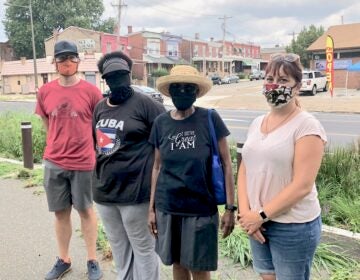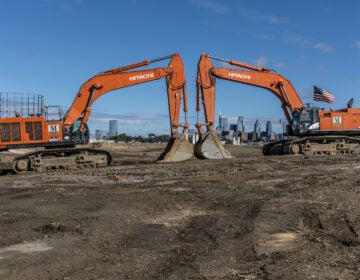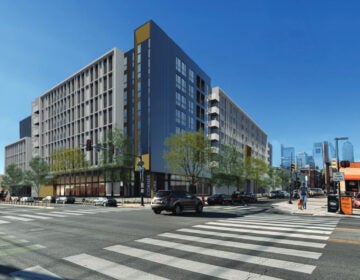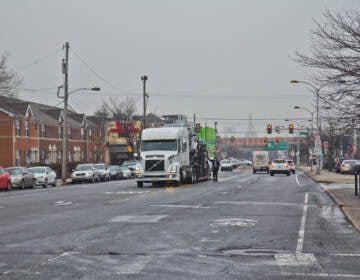Road diet! Washington Ave. slims down from 5 lanes to 3
The South Philly road is one of the city’s most dangerous. Many neighbors see the change as positive though some challenge the virtual engagement done.
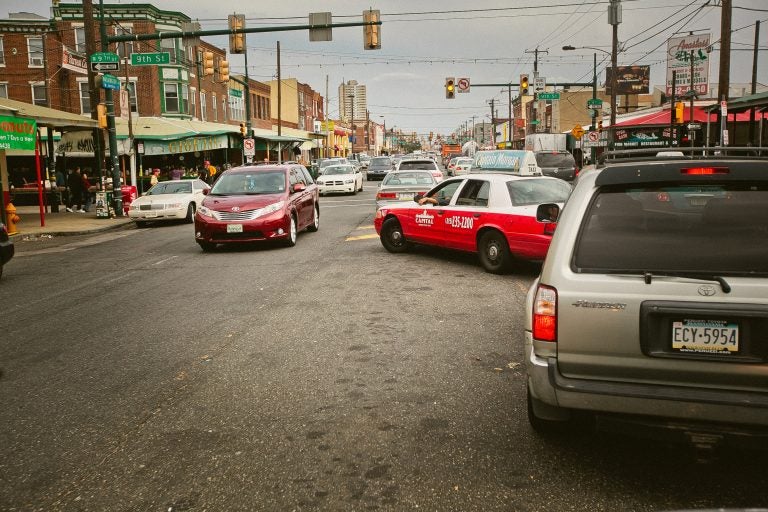
Traffic on Washington Avenue at 9th Street in South Philadelphia. (Neal Santos)
Washington Avenue is going to be reduced from five lanes of vehicular traffic down to three next year, with the goal of reducing crashes and fatalities on the major roadway that runs east-west through the tip of South Philly.
Construction is slated to start in the summer of 2021, along with the road’s regularly scheduled paving, and will bring a ton of change to the street. The road will turn to three lanes from Grays Ferry Avenue to 16th Street, and from 12th to 5th.
While there will still be parking on both sides, the parking lane will shift to the left of the bike lane — protecting cyclists from fast-moving cars. There will be more loading zones to prevent double parking, parking minimums and bus islands to accommodate Route 64 riders. The changes were based on a robust community survey, which asked residents how they wanted to see the street change.
The five-lane road, which runs from Queen Village through Southwest Center City and Point Breeze, is a major commercial corridor. It’s got a bustling Asian food scene and the Italian Market on the east side, plus a Target and Sprouts grocery store west of Broad — but high-speed traffic means it’s not always safe for pedestrians and cyclists. It’s a growing problem as a development boom in the gentrifying area transforms formerly industrial sites into homes.
Between 2012 and 2018, Philly’s Office of Transportation, Infrastructure, and Sustainability counted 254 crashes on the nearly three-mile road. Washington Avenue is also on the city’s High Injury Network — the 12% of city streets account for 50% of traffic deaths and injuries, according to Vision Zero data.
Albert Littlepage, who’s lived a half-mile south of Washington Avenue for 20-plus years, thinks the revamp will be positive for the community. But he’s not sure that the community engagement process reached his whole neighborhood.
“This makes a lot of sense to me,” said Littlepage, who’s the president of the Point Breeze Community Development Coalition. “But speaking to people who live closer to Washington, like on Ellsworth and Federal, they didn’t know about the survey.”
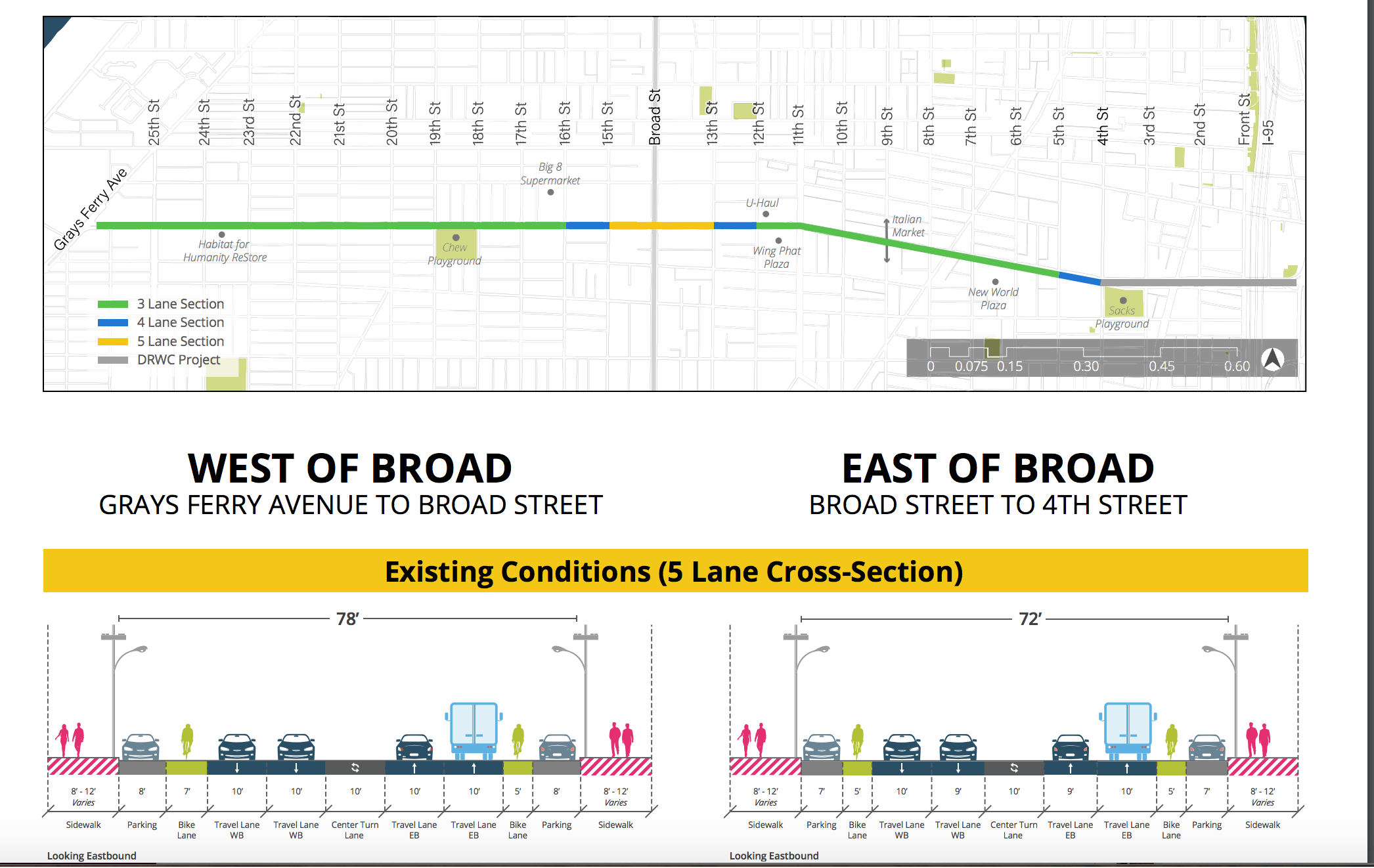
Neighbors see a ‘positive project’
Littlepage has noticed how dangerous Washington Avenue has become in his two decades living in the neighborhood.
He’s seen cyclists get run off the road by aggressive drivers. He’s known friends and family members who’ve been injured in traffic crashes. Over the summer, he saw a five-car pile-up happen in real-time at 16th and Washington.
“You notice these traffic patterns,” he said. “It’s really not safe for our children going to school.”
That’s why he’s eager for change to finally come to the thoroughfare — and he’s not the only one.
Seventy-year-old Jerry Sulat is the acting president of the East Point Breeze Neighbors group. He’s been nervous to ride his bike along Washington Avenue since he first moved to the neighborhood five years ago.
“It’s not a street I’m comfortable riding down,” Sulat said. “I look at this as a positive project. It’s certainly something that would benefit the entire environment. So I’m very positive for this.”
The plan that OTIS will begin implementing next year was one of three proposed for Washington Avenue: a three-lane roadway, a four-lane roadway or a mixed-lane option
The city conducted a large-scale community engagement project, reaching out to neighborhood groups and residents, and raked in 5,400 responses — an “overwhelming response,” per deputy managing director Mike Carroll. OTIS reached out via Zoom meetings, and by phone, text, mail and email. They distributed the survey in a variety of languages all over the avenue and sent postcards to every address between the north side of Christian and the south side of Ellsworth. They hosted 37 meetings with 26 community groups, and in the end, they picked the plan that 71% of people liked best: the three-lane roadway.
But some neighbors say they felt glossed over.
“The outreach and response probably didn’t reach some of the core African American community members,” Littlepage said. “There seems to be a concern that they didn’t really participate in the survey to the extent that other neighbors did.”
Doubts about virtual engagement
Claudia Sherrod, who lives near 22nd and Washington, said most of her neighbors did not hear about the project or the survey, despite the engagement efforts made by city planners to reach them.
“There were no community meetings as far as I know that brought the people out to speak on it,”said Sherrod, who’s lived in the neighborhood for 60 years.
Sherrod is not on board with the plan. She said she mostly gets around by car — and she’s upset that they’re reducing the road from five lanes to three because it’ll slow her down when she’s trying to get east to Delaware Avenue. In general, she thinks it’ll worsen congestion, making drivers feel like they’re in a “sardine box.”
City officials say that project planners personally met with Sherrod and have “spoken to her numerous times.” Littlepage attributes the disconnect between OTIS and his neighbors to the virtual community engagement process, imposed by the coronavirus pandemic.
“Typically we would’ve had a community meeting, and organized differently,” he said. “As opposed to sending out an email and waiting for a response. That may not be able to reach some seniors in the community, who don’t have the knowledge of social media. I believe people were missed.”
Though they support the plan, Littlepage and Sulat both have their reservations. Sulat wants more traffic enforcement in the neighborhood — ideally in the form of red light cameras at Broad and Washington. Littlepage thinks left-turn signals at each intersection would make it safer for people crossing Washington Avenue because drivers wouldn’t rush to turn when the light is yellow.
Before construction starts, Littlepage hopes the city starts a conversation with his neighbors who went unreached.
“This particular project I believe is in the best interest for everybody in the community,” Littlepage said. “We just need to be continuously talking about it, to continue to have a dialogue about it.”

Subscribe to PlanPhilly
WHYY is your source for fact-based, in-depth journalism and information. As a nonprofit organization, we rely on financial support from readers like you. Please give today.




